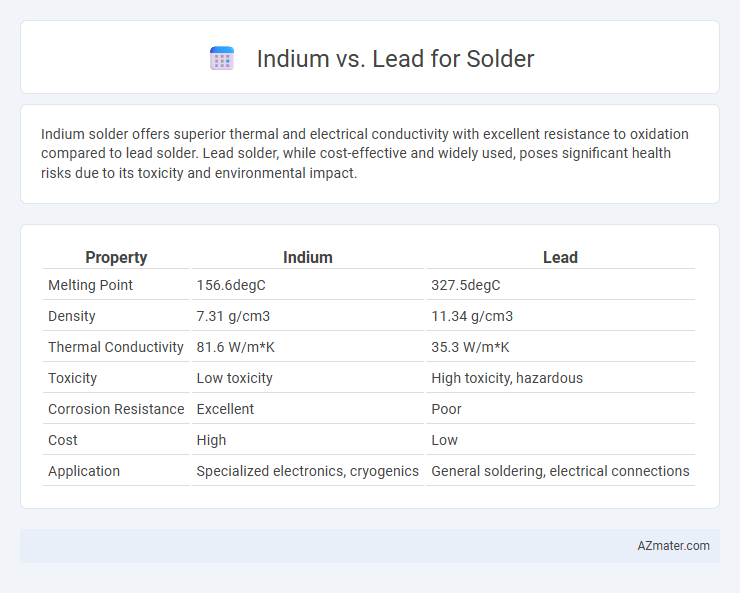Indium solder offers superior thermal and electrical conductivity with excellent resistance to oxidation compared to lead solder. Lead solder, while cost-effective and widely used, poses significant health risks due to its toxicity and environmental impact.
Table of Comparison
| Property | Indium | Lead |
|---|---|---|
| Melting Point | 156.6degC | 327.5degC |
| Density | 7.31 g/cm3 | 11.34 g/cm3 |
| Thermal Conductivity | 81.6 W/m*K | 35.3 W/m*K |
| Toxicity | Low toxicity | High toxicity, hazardous |
| Corrosion Resistance | Excellent | Poor |
| Cost | High | Low |
| Application | Specialized electronics, cryogenics | General soldering, electrical connections |
Introduction to Solder Materials: Indium vs Lead
Indium and lead are widely used solder materials, each offering distinct properties for electronics assembly. Indium provides excellent thermal conductivity, flexibility, and is non-toxic, making it ideal for high-reliability applications and cryogenic environments. Lead, known for its low melting point and good wettability, has historically been favored in traditional soldering but faces restrictions due to its toxicity and environmental impact.
Physical and Chemical Properties Comparison
Indium exhibits a low melting point of 156.6degC and excellent thermal and electrical conductivity, making it ideal for precise soldering applications, while lead, with a melting point of 327.5degC, offers greater mechanical strength in solder joints. Chemically, indium resists oxidation and corrosion better than lead, enhancing joint reliability in harsh environments, whereas lead poses toxicity risks and environmental concerns. The density of lead (11.34 g/cm3) is significantly higher than indium's (7.31 g/cm3), impacting the weight and structural characteristics of soldered components.
Melting Points: Indium vs Lead Solder
Indium solder melts at a significantly lower temperature of approximately 157degC compared to traditional lead-based solder, which melts around 183degC. The lower melting point of indium solder allows for sensitive electronic components to be joined with reduced thermal stress and enhanced reliability. This difference in melting points makes indium solder ideal for applications requiring precise temperature control and minimal heat exposure during assembly.
Electrical Conductivity Differences
Indium solder offers significantly higher electrical conductivity compared to lead-based solder, enhancing signal integrity and reducing resistive losses in electronic circuits. Lead solder typically has a conductivity around 4.8 x 10^6 S/m, whereas indium solder reaches approximately 1.2 x 10^7 S/m, nearly doubling performance. This superior conductivity of indium contributes to improved thermal management and more reliable electrical connections in high-performance applications.
Mechanical Strength and Flexibility
Indium solder offers superior flexibility and mechanical strength compared to lead solder, making it ideal for applications requiring durability under thermal cycling and mechanical stress. Indium's softness and ductility help absorb strains without cracking, whereas lead solder tends to be more brittle and prone to failure in dynamic environments. The enhanced mechanical performance of indium solder ensures longer joint reliability in electronics subject to vibration and thermal expansion.
Corrosion and Oxidation Resistance
Indium solder exhibits superior corrosion and oxidation resistance compared to lead-based solder, making it ideal for sensitive electronic applications exposed to harsh environments. Its natural oxidation layer is thin and self-healing, preventing further degradation and ensuring long-term reliability. In contrast, lead solder tends to form thicker oxide layers that accelerate corrosion, reducing joint durability and electrical performance over time.
Environmental and Health Concerns
Indium solder offers a safer alternative to lead solder due to its non-toxic nature and lower environmental impact, reducing risks of lead poisoning and soil contamination. Lead solder contains hazardous substances known to cause neurological damage and environmental pollution during production and disposal. Using indium-based solder aligns with stricter regulations like RoHS, promoting sustainable electronics manufacturing and minimizing long-term health hazards.
Application Suitability and Industry Usage
Indium solder offers superior performance in low-temperature and high-reliability applications, making it ideal for aerospace, medical devices, and cryogenic electronics due to its excellent thermal conductivity and ductility. Lead-based solder remains prevalent in general electronics manufacturing for its cost-effectiveness and ease of use, though its toxicity restricts use under RoHS regulations. The choice between indium and lead solder depends on industry demands for environmental compliance, mechanical stress tolerance, and operating temperature ranges.
Cost Analysis and Market Availability
Indium solder offers superior thermal and electrical conductivity but comes at a significantly higher cost compared to lead solder, whose price remains low due to abundant availability and established supply chains. Lead solder dominates the market in cost-sensitive electronics manufacturing, while indium solder is reserved for niche applications requiring high performance despite its premium price. Market availability of lead solder is widespread globally, whereas indium solder supply is limited by the scarcity of indium and concentrated production sources.
Future Trends in Solder Technology
Indium solder is gaining prominence due to its superior thermal conductivity and low melting point, enhancing precision and energy efficiency in advanced electronics manufacturing. Lead solder, constrained by regulatory restrictions like RoHS, is gradually being phased out in favor of eco-friendly, lead-free alternatives. Innovations in indium alloys forecast increased adoption in flexible electronics and high-reliability applications, aligning with future trends toward environmental sustainability and miniaturization in solder technology.

Infographic: Indium vs Lead for Solder
 azmater.com
azmater.com